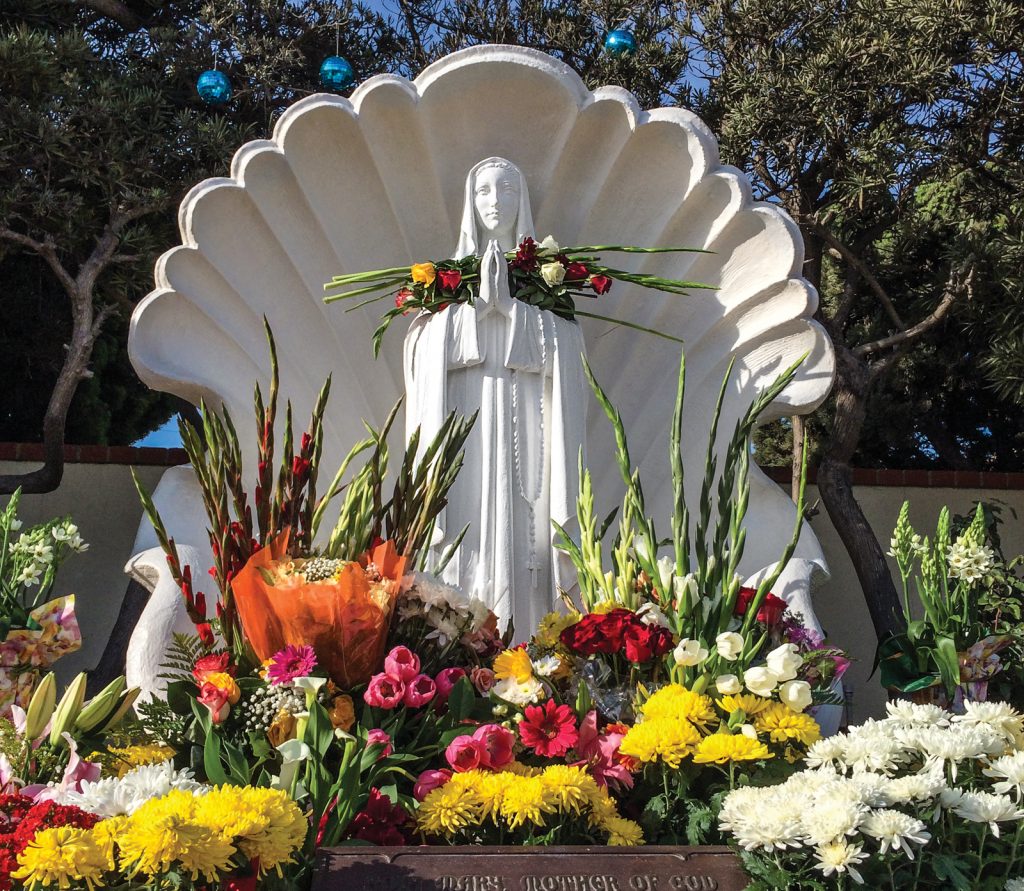At the door of Sagely Monastery in Long Beach, California, I am greeted by the smell of junipers cutting through the salty ocean air. There is an eerie quiet. The doors are shut, and there is no bell. The monastery, facing the Pacific Ocean, was closed to the public in March 2020, when COVID-19 hit. But even in normal times few visitors would go inside. Most would come to see something else—a statue of the Virgin Mary, preserved by the resident clergy decades ago, that has become a rare example of a place of worship for both Catholics and Buddhists.
Each week, hundreds flock to the corner of Ocean Boulevard and Redondo Avenue to pray, offer flowers, and give thanks to the monastery’s sparkling white statue of Mary on a half shell, known by locals as “Mary of the Sea.” She has become a magnet not just for Catholics and Buddhists but also for people of other religions, tourists, homeless people—and a self-proclaimed guardian who tells stories of miracles and angels appearing in selfies.
Sagely acquired the statue in the early 1990s when the organization that runs the monastery, the Dharma Realm Buddhist Association, purchased the former site of a Catholic Carmelite convent. “It’s a famous landmark in Long Beach, because the nuns lived and cultivated here for forty years,” wrote DRBA historian Helen Woo in In Memory of the Venerable Master Hsuan Hua, an anthology of writings about the Chinese Buddhist teacher who founded the association after coming to the United States in 1959. “When we bought the place, we asked them to leave the statue of the Virgin Mary in the front, because we also worship her, as Guanyin.”
It may be an oversimplification to say Mary and Guanyin are one and the same, but there are similarities. Guanyin, the bodhisattva of compassion, is a guardian of mariners and is often depicted in female form wearing all white (such as the great Guanyin statue in Chiang Rai, Thailand).
“Whether it is Jesus or Buddha doesn’t matter. If you believe, you believe.”
“Guanyin is portrayed as a figure of compassion and kindness,” said a nun who lives at Sagely Monastery (she preferred not to give her name). “She reaches out to all beings—to whoever needs help. She is very responsive.
“We say her name and practice her teaching every day,” she added. “That is one of our main practices here.”
For many who visit the shrine, there is no sharp line separating Buddhism and Catholicism.
“It’s no problem to believe in her,” said Lisa, a 70-year-old Buddhist practitioner who was born in Saigon. She has been coming to pray to Mary from her home in Orange County for more than five years, having found that the prayers relieve sadness. “Whether it is Jesus or Buddha doesn’t matter. If you believe, you believe.”
Laura Nguyen of Lawndale visits every week carrying fresh flowers for Mary. A Vietnamese American who grew up Buddhist, Ngyuen started coming in 2020 when her husband was diagnosed with stomach cancer. Today, after treatment at a Los Angeles hospital, he is cancer-free. Now she brings the flowers “just to give thanks.”
“I think the Virgin Mary teaches the same thing the Buddha teaches us. They are both very generous,” Nguyen said. “In our house, we have a shrine to the Buddha because of my culture. But I gave my daughter permission to change her religion to Catholicism. It’s all the same. It’s all about love, caring, support, and faith.”
In a way, Mary of the Sea has endured as a monument to the feelings of unity and solace that visitors experience in its presence.
“Anyone can find peace there,” said the Sagely nun. “It is an international spot of prayer, not just for one religion.
Thank you for subscribing to Tricycle! As a nonprofit, we depend on readers like you to keep Buddhist teachings and practices widely available.
